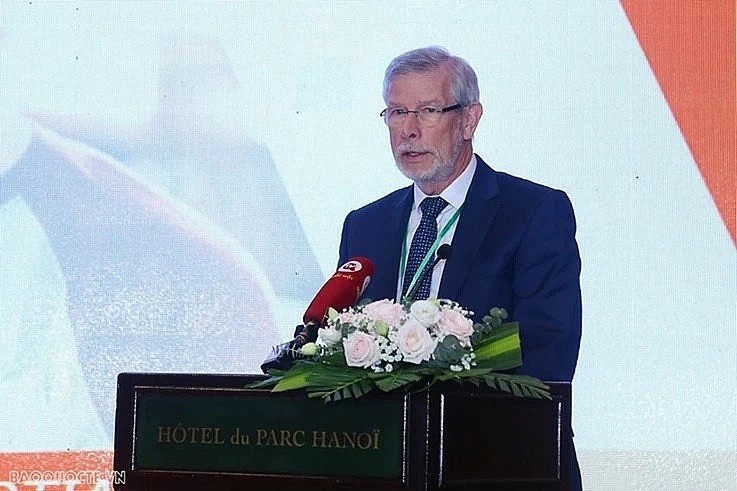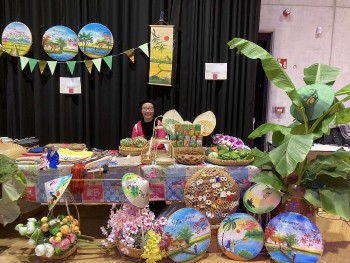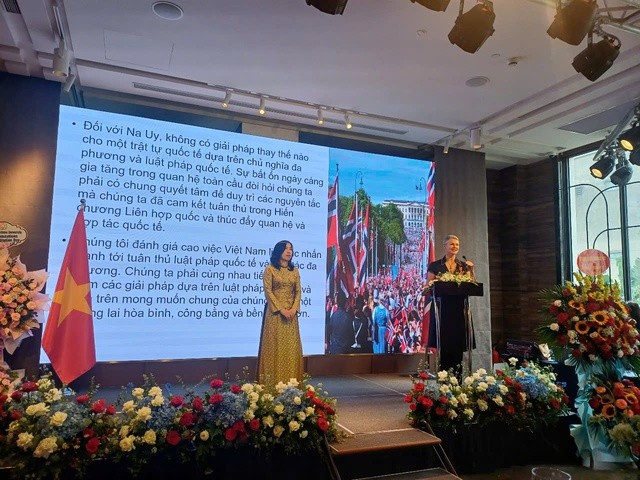Belgium's Experience in Dealing with Land Border Issues
| Vietnam Actively Promotes Peaceful Resolutions of Territorial Disputes | |
| Launching Ceremony of Vietnam Business Association in Belgium Takes Place in Brussel |
 |
| Belgian Professor Erik Franckx speaks at the Workshop. (Photo: Tuan Anh) |
Professor Erik Franckx has served as an advisor to numerous governments, international, inter-state, and non-governmental organizations on border issues and has been a member of the Permanent Court of Arbitration (PCA) and an arbitrator under UNCLOS since 2014.
Key highlights
Professor Erik Franckx highlighted that Belgium shares a 1,380 km land border with four countries: France (620 km), the Netherlands (450 km), Germany (162 km), and Luxembourg (148 km). These borders are characterized by their complexity and zigzag nature.
Belgium's borders were shaped through historical processes. During the independence struggle in 1830, Belgium was surrounded by European powers, making it challenging to establish land borders without guarantees from powers with no territorial ambitions.
Following periods of instability, where parts of the border shifted multiple times, Belgium's borders have remained relatively stable since World War II, with only a few minor adjustments made through agreements with neighboring countries.
Professor Erik Franckx emphasized two notable features of Belgium's land borders. First, the intricate borders in the Baarle Hertog/Baarle Nassau area between Belgium and the Netherlands, where territories of each country lie within the other. Second, the Scheldt River, a contentious point between Belgium and the Netherlands since Belgium's independence in 1830.
Land border issues are often scattered and complex. However, according to Professor Franckx, these challenges can be addressed through historical treaties or negotiations, although many require coordinated efforts and considerable time to resolve.
For instance, the border issues with the Netherlands serve as a typical example. The two countries have more than 400 border markers, yet the areas of disagreement, Baarle Hertog and Baarle Nassau, were not addressed by the 1843 demarcation treaty and were only partially resolved by the 1995 treaty. These areas still lack border markers to this day.
The search for solutions
In terms of management, Professor Erik Franckx believes that disputes over demarcation are typically resolved through negotiations. Due to the unclear nature of border markers, it is crucial to negotiate more effective solutions, adjust actual border markers, incorporate these adjustments into negotiation documents, and reach agreements with neighboring countries. Complex and ambiguous borders are highly likely to lead to disputes.
Additional border documents are necessary to facilitate prompt minor border adjustments. Resolving border conflicts should primarily rely on negotiations or International Court of Justice (ICJ) precedents.
According to Professor Erik Franckx, complex borders are prone to disputes, and the ability to resolve border conflicts through negotiations depends significantly on the willingness of the parties involved, and misunderstandings should be avoided. If issues arise, solutions can often be found in historical treaties. For instance, Belgium and France experienced a border incident in 2021, and if the situation had escalated beyond control, they would have convened a joint border commission based on an 1820 border treaty.
At key economic border crossings, Belgium permits free patrols and movement, reinforcing regional free movement agreements with its neighbors while still complying with international law. Belgium does not have a border fence, and although border marking is common, it can be extremely complicated in some cases. Occasionally, there are areas without markers, only signs indicating the border markers.
 | Vietnamese 'Ao dai' Heritage Club Promotes Traditional Cultural Values in Belgium The Vietnamese Ao Dai Heritage Club in Belgium has truly awakened national pride in the hearts of every Vietnamese living abroad, marking an important milestone ... |
 | Vietnamese-origin Females Run for Local Elections in Belgium On October 13, local council elections were held in Belgium, featuring three Vietnamese-origin female candidates in Brussels. These candidates represent three distinct political parties, including ... |
Recommended
 World
World
‘We stand with India’: Japan, UAE back New Delhi over its global outreach against terror
 World
World
'Action Was Entirely Justifiable': Former US NSA John Bolton Backs India's Right After Pahalgam Attack
 World
World
US, China Conclude Trade Talks with Positive Outcome
 World
World
Nifty, Sensex jumped more than 2% in opening as India-Pakistan tensions ease
 World
World
Easing of US-China Tariffs: Markets React Positively, Experts Remain Cautious
 World
World
India strikes back at terrorists with Operation Sindoor
 World
World
India sending Holy Relics of Lord Buddha to Vietnam a special gesture, has generated tremendous spiritual faith: Kiren Rijiju
 World
World


